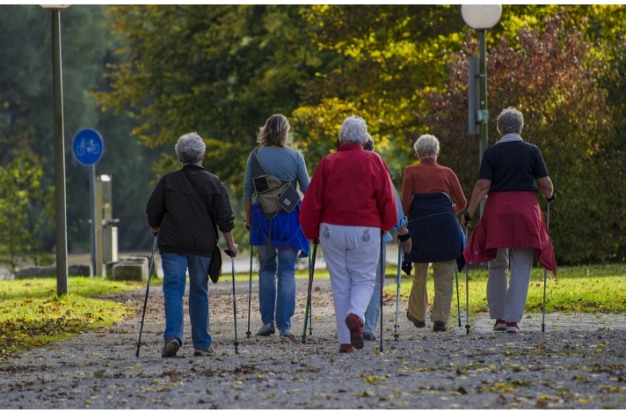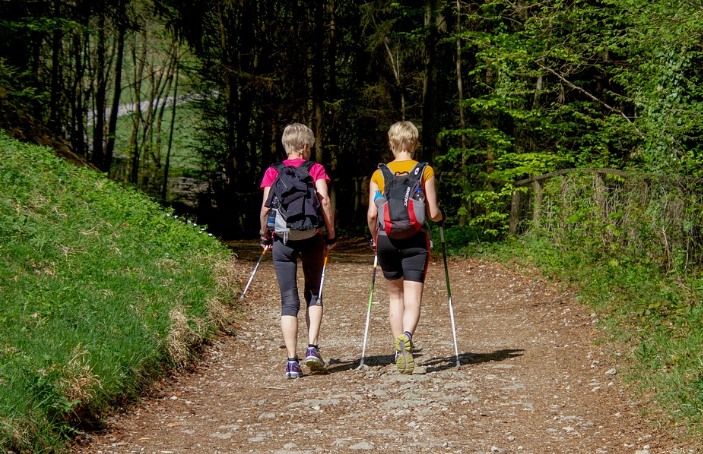
What is Nordic Walking – Benefits of Nordic Walking
You may be familiar with the term “Nordic walking,” but what does it actually entail? The term refers to a low-impact, but intensive, walking style that uses poles to propel yourself forward.
We already know how beneficial walking can be as a form of fitness. But how does Nordic walking differ? What are the health benefits? And how long should you do it for? To discover everything you need to know about the exercise, we’ve done the research, put questions to an expert and compiled all the information.
Table of Contents
What Is Nordic Walking?
Nordic walking is a full-body, low-impact workout that consists of walking using specialized poles. When done correctly, it can engage up to 90% of your muscles and offer an intense cardiovascular and strength-training workout, according to experts.
Nordic walking originated in Finland and is a whole body walking exercise that anyone can do for physical fitness and fun. Nordic walking uses two specially designed poles to work the upper body while walking. Like cross country skiing, the poles are used by the arms to match each step the person takes. When participating in Nordic walking, you get a boost in intensity from the arm activity.
How Do You Nordic Walk?
The key is to not overcomplicate it, the experts noted. The technique involves walking holding each pole alongside your body and moving the poles in opposition to your legs so they are at a 45-degree angle, according to the American Nordic Walking Association (ANWA) which has a free beginner’s guide on their website.
Nordic walking poles come in one-piece, non-adjustable shaft versions, available in varying lengths, and telescoping two or three-piece versions of adjustable length. Telescoping poles are ‘one-size fits all’, and are more transportable.
The Benefits Of Nordic Walking
It Boosts Your Exercise Capacity
A study published in the International Journal of Sports Medicine(opens in new tab) investigated the effects of a Nordic walking program versus a walking program for obese middle-aged women over the course of 12 weeks. It had interesting results.
After the 12-week program, researchers found: “Nordic walking activity in obese women allows an increase in exercise intensity and adherence to a training program without increasing the perception of effort leading to enhanced aerobic capacity.”
But why is this? According to Stewart: “Nordic walking enables you to keep the weight off the lower body joints and – because the poles are supporting you and providing propulsion – it makes it feel easier. But you are working harder because you are bringing in your other body muscles.”
Relaxes The Upper Body
Walkers have used a variety of techniques and equipment to add an upper body workout to their walk. Correct arm motion can relieve neck and shoulder tension while toning upper body muscles. Racewalkers use their arms effectively to give an upper body workout.
Using the correct Nordic walking technique with relaxed shoulders, keeping the poles behind the body and using a full range of motion, the walker also releases stress carried in the shoulders and neck. Taking the arms and shoulders through the full range of motion throughout a 30-minute walk is a great antidote to the slouching many people do over desks and computers.
It Increases Oxygen Uptake
Nordic walking might be a low impact form of exercise, but that’s not to say it doesn’t provide a lot of bang for its buck.
In an article published in the American Journal of Preventive Medicine(opens in new tab), researchers found that in comparison to brisk walking without poles, Nordic walking increased VO2 max measures (the amount of oxygen you breathe in while exercising as hard as you can) by around 11%-23%. The more oxygen you inhale, the more energy your body can use. Having a higher VO2 max usually means better physical fitness.
It Increases Muscle Strength
According to a study in Asian Nursing Research(opens in new tab), Nordic walking “helps people use not only the lower body, but also all the muscles of the upper body”. The result? “This decreases the load that occurs while walking and could help to increase muscle strength,” researchers conclude.
Stewart agrees. “In its raw format, Nordic walking is a difficult thing to master but also to maintain, because you are using 90% of major muscles. It works out all of the large muscles like the legs, buttock, it engages the core and uses the shoulders and arms as well,” she says.
It Improves Balance And Posture
In 2021, a report in Healthcare(opens in new tab) looked into the influence of Nordic walking on spinal posture and concluded that: “A Nordic walking training program has a potential to improve upper and lower body strength and balance.”
It Can Burn More Calories Than Walking
Much like walking on a treadmill can help you lose weight, Nordic walking can help you shed pounds, too. A review published in the American Journal of Preventive Medicine(opens in new tab) found that the short-term benefits of Nordic walking in comparison with brisk walking without poles included an increased caloric expenditure of between 18%-22%.
It’s Mood Boosting
Much has been said about the mood-boosting impacts the outdoors can bring. And as stated in the journal Frontiers in Psychology(opens in new tab): “Proximity to green space has been associated with lower levels of stress and reduced symptomology for depression and anxiety.” So as long as you’re Nordic Walking somewhere scenic, you could improve your mood.
Stewart adds: “You have got the mood-boosting benefits of being outdoors and in nature – and it’s a rhythmical movement that can feel really mindful when you’re doing it.”
Equipment Options
Athletes and military personnel in Finland have been using walking poles during their summer walking and running workouts for decades. Several varieties of Nordic walking poles are on the market for use in Nordic walking techniques. There are several options and features that you may want to consider
Release Systems
There are different glove or strap release systems. Leki Nordic walking poles have an easy to use release system so you can quickly remove your hand and the demi-glove from the poles, and quickly click them back to the poles. This is very helpful for restroom stops, etc.

Grips
With the Nordic walking technique, the walker does not need to grip the pole at all, it travels via the strap/glove. A true Nordic walking pole does not have a grip that flares at the bottom of the hand, as that hampers releasing the grip at the back of each arm swing. Flared-bottom grips are used in trekking poles where the hiker may bear down on them. Nordic walking grips are usually streamlined and narrow.
Materials
Materials may includealuminum or carbon fiber. Claims are made for the superiority of each for shock absorption, and durability. Some poles are heavier, some very light. In general, adjustable poles or spring systems add weight to the poles.
Telescoping
Poles may be adjustable or fixed length. The length of the pole is critical to being able to use the right technique. A fixed-length pole is usually the lightest weight choice, and on even terrain, there is no need to adjust the pole height. But for those who want to share the poles or want to be able to more easily pack them, telescoping poles are desirable. Check the pole for a good locking system that is easy to adjust yet resists loosening accidentally.
Tips
You’ll use spike tips for nature trails and rubber tips for sidewalk or road walking. The rubber tips should be secure enough to stay put, yet easy to remove when you want to use the spike tip.
Cushioning
Springs or other cushioning systems are elements that are more appropriate for trekking poles, but are found on some Nordic walking designs.
Lastly, you’ll want to consider wrist straps and demi gloves. A comfortable demi-glove is essential to ease of use with Nordic walking poles. The glove should fit well and not cause chafing. These glove systems are constantly improving, check the latest models. For some brands, you can order replacement gloves for the newest design.
Conclusion
Although Nordic walking is an excellent exercise option, it does have some cons that may hinder some people from upholding it. Some of the disadvantages of Nordic walking include the costly expenses, risk of tripping, complex and time-consuming techniques, discomfort, and interruption of other simple activities. Be sure to go through this list of Nordic walking disadvantages with an expert if you are still interested in this activity.